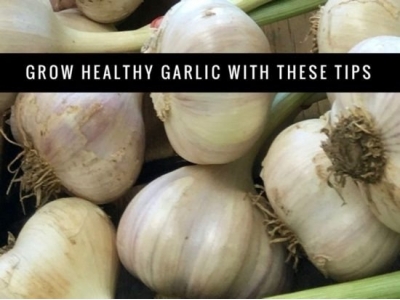How to Grow Garlic

Want to learn how to grow your own garlic? This guide will teach you the basics.
Varieties of Garlic
The most common type of garlic found in stores is artichoke garlic, which also is easy to grow at home in your garden. The savory bulbs are closely related to onions, and can be found in many varieties of two types: hardneck and softneck garlic.
Hardneck garlics come in dozens of bulb varieties and are considered the “original” or native garlic, while various growers for commercial production have cultivated softneck garlics, and these are the kinds usually found in supermarkets. You may want to try growing a different type of garlic best suited to your climate. Creole garlics are adapted to warm weather, while porcelain garlic grows better in northern regions.
Conditions for Growing Garlic
Garlic will grow on a range of soils, but prefers a loamy soil rich in organic matter. The soil should be in the neutral pH range, from 6.5 to 7.0 for successful garlic growing. If your soil doesn’t meet these qualifications, add compost, humus or manure before planting garlic, and mix the soil well. Amend the soil pH if needed with lime or sulfur.
To grow bigger garlic, add plenty of 10-10-10 fertilizer throughout the growing season. Use an irrigation system or regular watering. If the bulbs are in dry soil, they tend to grow unevenly, so keep the soil moist for best results.

Planting Garlic
Garlic requires a fairly long growing season and can either be started indoors in the spring or outdoors in the fall. The plants begin to produce bulbs quickly in warm temperatures, so indoor plants should be strong enough to support the bulbs before they go outside. In zones 4 to 6, plant garlic in March or April. In warmer zones, plant garlic in the fall, letting it establish some roots before going dormant. It will then come up on its own in the spring.
Sow garlic outdoors anytime after September, or after the first frost, when the nights are cold enough not to encourage germination. Garlic is not grown from seed; to plant it, separate the cloves of a bulb and plant the larger, outer cloves. Place them in soil about a half-inch to an inch deep in an upright position, about three to five inches apart.
Garlic Care
Water garlic regularly and keep the soil moist, but not wet. A rain gauge might be helpful for you to determine how much you need to water. In dry areas, mulch will be beneficial to help the soil stay moist evenly. Fertilize once a month at the start of the growing season by sidedressing the plants or using liquid fertilizer. Stop fertilizing when the plants begin to produce bulbs, since the fertilizer will encourage leaf growth rather than bulb growth.
Harvesting Garlic
You can harvest garlic as needed throughout the summer. Stop watering in the fall a week or so before you plan to harvest the rest of your garlic, to let the soil dry out for easier harvesting. Dig up garlic bulbs rather than pull them from the surface, to reduce injury to the bulbs and breakage of the stems. This is easily done with a hand cultivator or trowel in a home garden, but should be done before frost sets in for ease of digging.
Let the tops of the plants dry before storing garlic. When the tops are dry, cut them off an inch or so from the bulb. Garlic bulbs should be stored at 32 degrees Fahrenheit for the winter. Too much warmth and humidity in their storage location will encourage mold. Garlic should last six to seven months stored well.

Common Problems with Growing Garlic
Growing underground, garlic is not as susceptible to insects and diseases as some garden plants, but it has been known to be affected by the onion maggot. The leaf tips will show yellowing or browning if infected; pull the garlic and discard it to keep the bug from moving on to other bulbs.
Fungi and nematodes also should be guarded against with root crops. You can avoid fungi and nematode infestations in your soil be making sure the garden bed is well-drained and kept at a constant moisture level, not letting it get too wet or too dry.
Related news
 Growing Marigolds: Tips and Tricks
Growing Marigolds: Tips and Tricks Interested in having a flower garden? Look no further...Marigolds are easy to grow and have many uses.
 How to Water Seeds and Seedlings
How to Water Seeds and Seedlings Water is one of the vital elements when starting plants from seed. Too much water and your seeds will drown or rot. Too little and they will either fail
 Growing Blueberry Bushes: Tips for Success
Growing Blueberry Bushes: Tips for Success Ready to grow your own blueberries? These tips will help you grow great blueberry bushes.